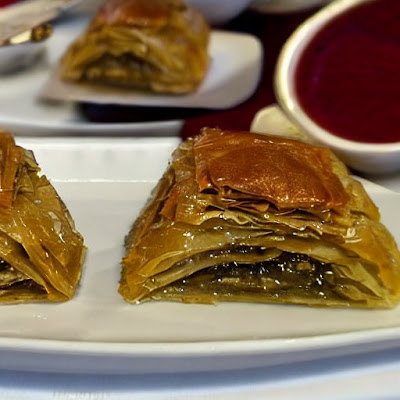Baklava is a delicious and popular sweet pastry that originates from the Middle East and Mediterranean regions. It is made with layers of thin pastry sheets, known as phyllo or filo dough, and filled with chopped nuts, usually walnuts, pistachios, or almonds. The layers are then held together with sweet syrup or honey, giving baklava its characteristic sweetness and moist texture.
Key features of baklava:
Origins: Baklava's exact origins are debated, but it is believed to have been developed in the imperial kitchens of the Ottoman Empire. Its history can be traced back to ancient times when layered bread desserts with nuts and honey were enjoyed in the Middle East.
Phyllo Dough: Phyllo dough is a crucial component of baklava. It is paper-thin pastry dough made from flour, water, and a small amount of oil or butter. When layered, it creates a flaky and crispy texture, providing a perfect contrast to the nutty filling.
Nut Filling: The nuts used in baklava are typically ground or finely chopped, mixed with sugar and sometimes flavored with spices like cinnamon or cloves. The most common nuts used are walnuts, pistachios, and almonds, though regional variations may include hazelnuts or other local varieties.
Layering and Assembly: To make baklava, multiple layers of phyllo dough are brushed with melted butter or oil and stacked. The nut mixture is sprinkled over the layers at regular intervals. The process is repeated until there are several layers of phyllo and nuts.
Cutting and Baking: Once assembled, the baklava is cut into various shapes, such as triangles or diamonds, before being baked in the oven. The pastry becomes crispy and golden brown, and the nuts inside are toasted to enhance their flavor.
Syrup or Honey: After baking, the hot baklava is drenched in a sweet syrup or honey mixture. This syrup seeps into the layers, making the dessert wonderfully moist and adding a rich sweetness to each bite. The syrup is often flavored with rose water, orange blossom water, or other extracts to enhance the overall taste.
Regional Variations: Baklava comes in various regional variations, with different countries and cultures adding their unique twists to the classic recipe. For example, Turkish baklava tends to use pistachios and has a lighter sweetness compared to the Greek version, which frequently includes honey and walnuts.
Baklava is a beloved dessert in many parts of the world, and its popularity has spread far beyond its original homeland. Its delicate layers and rich flavors make it a delightful treat for special occasions or as a sweet indulgence any time of the year. Whether enjoyed at home, in a local bakery, or during travels, baklava is sure to satisfy anyone's sweet tooth.
Source: Some or all of the content was generated using an AI language model


No comments:
Post a Comment